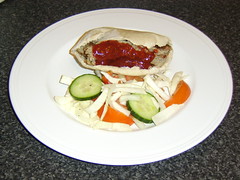
There is an air of mystique surrounding the making of sourdough bread.
Any fool can knock together a simple loaf using bought yeast cultures but it takes a special type of fool to attempt catching and nurturing these teeny organisms then harnessing their unique power to create a loaf of bread.

Sourdough appeals due to its infinite variety: the special combination of flavours, textures and smells that results from the singular
terroir of an area. As pretentious as that sounds its true – the airborne yeast cultures, the flour and the water are all unique. Sourdough bread made in Paris will be noticeably different to one made in San Francisco.

Previous efforts have invariably resulted in failure. Flat, puddle like breads that spread out over trays like an overly ripe cheese. Bitter tasting efforts with dense centres more suitable for constructing buildings than contributing to breakfast.

But, by Jove, I think I’ve cracked it.
After two days relentless study and nearly a month of stirring, waiting, mixing, kneading, waiting and baking here is a completely foolproof, day-by-day guide to making that most magical of breads.
 Sourdough Bread
Sourdough BreadThis is undoubtedly slow food. But it’s certainly worth the effort.
Sourdough is made in three stages: first you create a starter dough. The starter dough is then used to make a sponge and the sponge used to make a loaf with a little held back as the next starter.

Beautifully and simply cyclical.
All you need to do is remember the following ratios:
50:50
60:40
70:30
That is to say, the starter should be half flour and half water. The sponge 60% flour and 40% water and the final loaf around 70% flour to 30% water.
Other than that the only ingredient is salt.
Salt performs two functions. Firstly it adds flavour to the bread but more importantly it inhibits the growth of bacteria which can quickly spoil a starter dough.
You’ll also need a largish jar with a lid.
Day One – mix together equal parts of white bread flour and water. Stir and pour into the jar. Leave the lid off for a few hours then loosely close it. Let it stand overnight in a warm place – between 16 and 18°C
Day Two – Pour off half the mixture and discard. Stir in equal parts flour and water, a little salt, close the lid and leave in the fridge. Why? Bacteria struggle to multiply at lower temperatures whereas yeasts flourish.
Day Three – repeat as day two but add some rye flour to the mix. Rye flour is high in natural yeast cultures. The mix should be bubbling away now and giving off a slightly acidic smell. This is good. If you fancy speeding up the process, leave the jar out of the fridge for a few hours to accelerate the fermentation.
Days Four, Five and Six – Repeat as above.
Day Seven – After a week your starter dough should be nicely fermented with a healthy ‘sour’ niff. It might even smell faintly boozy. Give it a stir then tip into a mixing bowl to make the sponge. Add flour and water to a ratio of 60:40 (go for about 180g flour – a mixture of white, wheat and rye if you wish – and 120g water) and a sprinkle of salt. Stir well and cover with plastic wrap. Leave in a warm place for 12-24 hours.
Day Eight – Pour half the sponge back into your (now clean) starter jar, stir in a 50:50 mix of flour and water and pop it back into the fridge. This only needs refreshing once every few days now.
Add flour and water in a ratio of roughly 70:30 (for a large loaf or two small ones you will probably need 420g flour and 180g water) and a pinch of salt. Stir to combine and then turn out onto a floured surface. The dough should be quite wet. Knead and add more flour as necessary to create a dough that doesn’t stick to the surface but retains its lax and slouchy feel. Knead well for 15 minutes or so then return to the bowl, cover with plastic wrap and leave to double in size. This could take anything up to three or four hours.
After the volume has doubled, turn the dough back out onto the floured surface, swiftly knock the air out of it and shape your loaf or loaves onto a baking sheet. Sprinkle the tops liberally with flour and cover with a slightly damp tea towel. Leave to rise for another hour.
Preheat the oven to full whack and put a bowl of water on the bottom shelf. Slash the top of the loaf to allow the bread to rise properly in the oven (a phenomenon known as ‘oven spring’ as the gas bubbles inside the loaf quickly expand due to heat) and cook for 10 minutes. Turn the oven down to 120°C and give it another 15-20 minutes. It’s ready when it sounds hollow when tapped on the base

For more 'loafing' around, why not potter over to
Twitter?

















